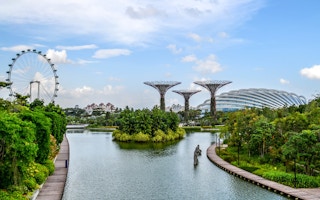When asked about efforts by local government to make cities more sustainable, people will name solar panels on public buildings or green city buses. But behind those very visible elements of sustainable smart cities, lies a whole host of ‘hidden’ innovative tech that is set to improve citizen lives on a social, economic and environmental front. To the benefit of everyone.
I frequently get asked about what the city of the future will look like. My honest answer is that it is far more about what smart cities will feel like. When we consider our choice of home, neighborhood and city, we name rational reasons. But we choose to stay because of how comfortable we feel there. A large part of this level of comfort has to do with the services we can rely on, and the ease of use and living we can gain from leveraging the latest, innovative technology.
Take my relocation from Germany to Singapore, two years ago. Recent studies found Singapore to be the world’s most prepared city for the age of artificial intelligence, as well as #1 in terms of smart city efforts, and I can’t agree more.
From banking to choosing an electricity provider to receiving my employment pass, I couldn’t believe how easy things were. My experience in Germany was that arranging many government services was still mostly paper-based; in Singapore I could make all arrangements online, in a matter of minutes.
What made my experience so positive, was that it was simple. From my end of course; the intricate technology that made these services possible were hidden from view. From a city perspective, this is vital to a fantastic citizen experience.
We frequently see cities planning to use innovative technology such as AI, the Internet of Things, and hybrid cloud to become ‘smart cities’, but relatively few focus on the bigger, strategic social and economic opportunities and challenges that come with it.
When we work with local governments to make their smart cities plans a reality, we always start with the experience they wish to deliver for citizens and employees – the people. We ensure that the tech angle comes later, because frankly, the sensors, software and hardware are only a means to an end.
The notion of making sure technology is not ‘in your face’, is especially true when it comes to smart city efforts. Take sustainability for example. Although 9 out of 10 Singaporeans indicate concern about climate change, many will choose convenience over eco-friendly, might have a limited budget, or even have no idea how to contribute to sustainability efforts.
“
We frequently see cities planning to use innovative technology such as AI, the Internet of Things, and hybrid cloud to become ‘smart cities’, but relatively few focus on the bigger, strategic social and economic opportunities and challenges that come with it.
City governments can ensure everyone contributes automatically, and without any effort on their part. For example, they may offer emission-free public transport, install lamp posts that reduce energy usage, leverage optimised water management via sensors in pipelines, develop safe cycle lanes, install electric vehicle charging points and maintain space for nature.
Singapore is a hero to many, having already implemented much of these practices, and committing to do more. The government has promised to lower energy consumption by 35 per cent by 2030 and aims to achieve Green Mark Certification for 80 per cent of buildings.
Just a few months ago, the National Climate Change Secretariat polled the general public for wild ideas that would lead to Singapore becoming a low carbon city. These efforts contributed to Singapore being named Asia’s most sustainable city.
Can we do more? Of course we can. Long-term strategic technology choices will be instrumental in ensuring all of Asia’s cities are not only sustainable, but also a great place to live in future. That makes the choice of this year’s World Cities Day theme, which always falls on 31 October, a perfect fit: ‘Changing the world: innovations and better life for future generations’.
City governments across the region should consider the full spectrum of sustainability: environmental, social and economic sustainability. This goes beyond flashy headline innovations such as drone deliveries and vertical farming, to creating a long-term vision for leveraging the power of the internet to create new paths of economic prosperity for all, including supporting a future where everyone can securely access the economic, educational and healthcare opportunities they need.
From an environmental sustainability perspective, connected buildings, buses, cars, street lights, pipes and waterways will ensure the optimisation of energy and other resources. If you know there’s a leak or a fire, you can act on it, as well as make and measure improvements to consume less energy. This effort should be invisible, seamless, but profitable for every citizen. That is because the funds that are saved on these mundane services can be reinvested in people, services, roads, parks, and the creation of jobs.
From a social sustainability angle, governments need to be confident that their services are accessible and easy to use for everyone. Unfortunately, citizen’s tech savviness varies tremendously, meaning that governments need to be flexible enough to cater to baby boomers as well as Gen Z’s with inclusive services that don’t alienate anyone.
Services such as renewing your driver’s license should be possible in a variety of ways; let’s say the best solution for me lies somewhere between a physical counter and Snapchat. Software can ensure that everyone receives the same services, but in ways that work for them.
Lastly, economic sustainability. A city needs to be a center for the local economy, attracting businesses, investments and workers, and continuously creating jobs, if the city is to survive long-term. This last point especially, plays into Cisco’s vision of an inclusive future.
To make this a reality, cities should take note of Singapore’s strategies and expand their current smart city initiatives to not only include sustainability practices, but make it a key pillar for a smart future. Second, execute that strategy together with partners from the private sector that can showcase a history of deep care for sustainability. Lastly, select a vendor that can match this end-to-end strategy with a wide portfolio of products and services; literally able to deliver both the sensor on the red light to the application that manages traffic congestion.
A recent Oliver Wyman Forum study found that although megacities like New York and Paris have well-scaled business communities and talent pools, smaller cities can be just as competitive technology-wise, assisting their climb to the top of the smart city list. Cities in Asia, Singapore included, should take this to heart and continue to forge ahead in the smart city field, lead in terms of sustainability, and prove the region is a great place to live.
Yasser Helmy leads Cisco System’s Smart City efforts in Asia Pacific, Japan and China.


















